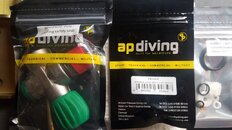This thread has an implication that the problem with oxygen fires is the valve. The main cause of oxygen fires is heat from adiabatic process that ignites a kindling chain that starts with contamination. The valve itself is unlikely to be the cause of a fire, even the speed the valve is opened is unlikely to be the cause if it's a threaded opening design (slow opening or not) as long as it's not a quarter turn ball design. There are lots of designs for oxygen valves, the typical CGA 540 cylinder valve opens as fast or faster than the typical SCUBA valve. The rapid opening Thermo nitrox scuba valves actually passed the V9 ignition tests for 3000 psi service pressures (which means they were tested for ignition with instantaneous open at 5000 psi.) No valve that says it can be used with any nitrox mixture greater than 23.5% oxygen is going to have an improper gas path.
Discarding natural selection in the operator handling the oxygen cylinder, in my experience its contamination of the DIN fittings on scuba valves and regulators that is the usual cause of oxygen fires. The contamination isn't something obscure or the wrong o-ring... its lube on the threads, even oils from your fingers and hands, but I suspect the worst offender is polyester lint from clothing. (Blow out the valve before coupling the DIN fitting to the outlet.) The valve design does very little to protect from contamination (although eliminating chromed surfaces can help). The other area I often encounter contamination is in the neck threads, especially where the neck threads were lubed (the kind of lube doesn't really seem to make a difference.) I've seen as many fires that started in the neck threads from a right angle impact on the valve, as I've seen start in the outlet/regulator interface. I've also seen fires that started inside 1st stages. When servicing valves and regulators over the years I've seen evidence of many fires in valve outlets and 1st stages where the kindling chain never escalated. Want to know where I've never seen an oxygen fire start? Inside the valve, although I'm sure it happens I've never seen it.
If it makes you feel safer to have a particular valve on your scuba cylinder full of oxygen, go ahead, but don't delude yourself into thinking that will somehow significantly reduce risk of an oxygen fire.





